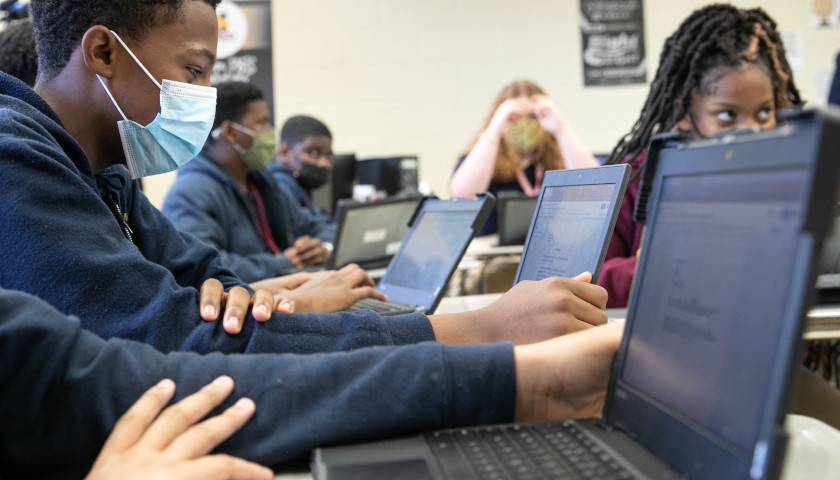A study released last week found more than one in three children in grades K-3 are unlikely to be reading on grade level by the end of the current school year unless they receive major remedial help.
Curriculum and assessment company Amplify analyzed data from more than 400,000 students in kindergarten through fifth grade and found that, while students have begun to rebound from the learning loss suffered during school closures amid the coronavirus pandemic, considerable gaps remain in basic reading skills, Education Week reported.
More Than 1 in 3 Children Who Started School in the Pandemic Need 'Intensive' Reading Help https://t.co/zgNCT1hQ2u pic.twitter.com/RGmw5jThoC
— Education Week Teacher (@EdWeekTeacher) February 16, 2022
According to the report, researchers compared students’ reading achievement scores on the diagnostic tool Dynamic Indicators of Basic Early Literacy Skills (DIBELS) during the period from 2019 through 2022.
The investigators then matched midyear test scores from more than 1,300 schools in 37 states from 2019-2020 through 2021-2022.
Results showed fewer students are reading at grade level now than prior to the school closures, with the earliest grades showing the greatest struggles.
Education Week reported:
For example, from 2019 to 2022, the share of students who are on track in reading by the middle of the school year has fallen from 55 percent to 47 percent in kindergarten, 58 percent to 48 percent in 1st grade, and 59 percent to 51 percent in 2nd grade. By contrast, 57 percent of 5th graders are on track in reading, only a single percentage point lower than the on-track share pre-pandemic.
Paul Gazzerro, Amplify’s director of data science, said that while some signs of recovery are now apparent, the reading skills of black and Hispanic students, who had been struggling even before the pandemic, deteriorated even further during the school closures.
Declines in U.S. student performance have been reported regularly, however.
In April 2020, the Boston-based Pioneer Institute published a study that found a historic drop in national reading and math scores since the adoption of the Common Core State Standards in most states.
@tomloveless99 Study Finds Historic Drop in National Reading and Math Scores Since Adoption of Common Core Curriculum Standards – Pioneer Institute https://t.co/mdFJu4c0YJ
— Pioneer Institute (@PioneerBoston) May 2, 2020
The study revealed that, while Common Core was touted as yet another reform that would shrink the achievement gap between students from lower-income families, and those from middle- and upper-class backgrounds, a decade later the gap is even wider – pre-pandemic.
The Pioneer Institute study observed, for example, regarding the post-Common Core NAEP math scores for grades four and eight:
The declines are most acute for the lowest-achieving students, increasing inequality. Scores for students at the 90th percentile have mostly continued their pre-Common Core trend of gradual improvement. But the farther behind students were, the more substantial the declines, with the biggest drops occurring for those at the 25th and 10th percentiles.
Following the release of the Nation’s Report Card [National Assessment of Educational Progress] math and reading assessments for fourth- and eighth-graders, Dr. Peggy Carr, associate commissioner for assessment of the National Center for Education Statistics, said in October 2019, “Over the past decade, there has been no progress in either mathematics or reading performance.”
“The lowest performing students – those readers who struggle the most – have made no progress in reading from the first NAEP administration almost 30 years ago,” Carr added.
Dr. Peggy Carr, Associate Commissioner, notes that the lowest performing students–those readers who struggle the most–have made no progress in reading since the first assessment almost 30 years ago. Learn more: https://t.co/EWajchXvIH#NAEPDay pic.twitter.com/9zanK5fPmv
— NAEP, The Nation's Report Card (@NAEP_NCES) October 30, 2019
Now, Gazzerro said, the achievement gap has widened further due to the pandemic school closures.
“There’s one group below benchmark—think of them as … ‘bubble kids,’ you know, the ones who probably need strategic support that could be offered within the classroom, but don’t need to be pulled out for something more intensive,” he said. “And then [there are] kids who are least likely to be successful at the end of the year, these kids we’re identifying as at-risk.”
According to the researchers, the “at-risk” students have only a 20 percent chance of reading on grade level by the end of the academic year without intensive remedial help. At this point, at-risk students represent more than a third of K-3 students and more than a fourth of grades 4-5 students.
– – –
Susan Berry, PhD, is national education editor at The Star News Network. Email tips to [email protected].
Photo ” Students Learning” by U.S. Department of Education. CC BY 2.0.




